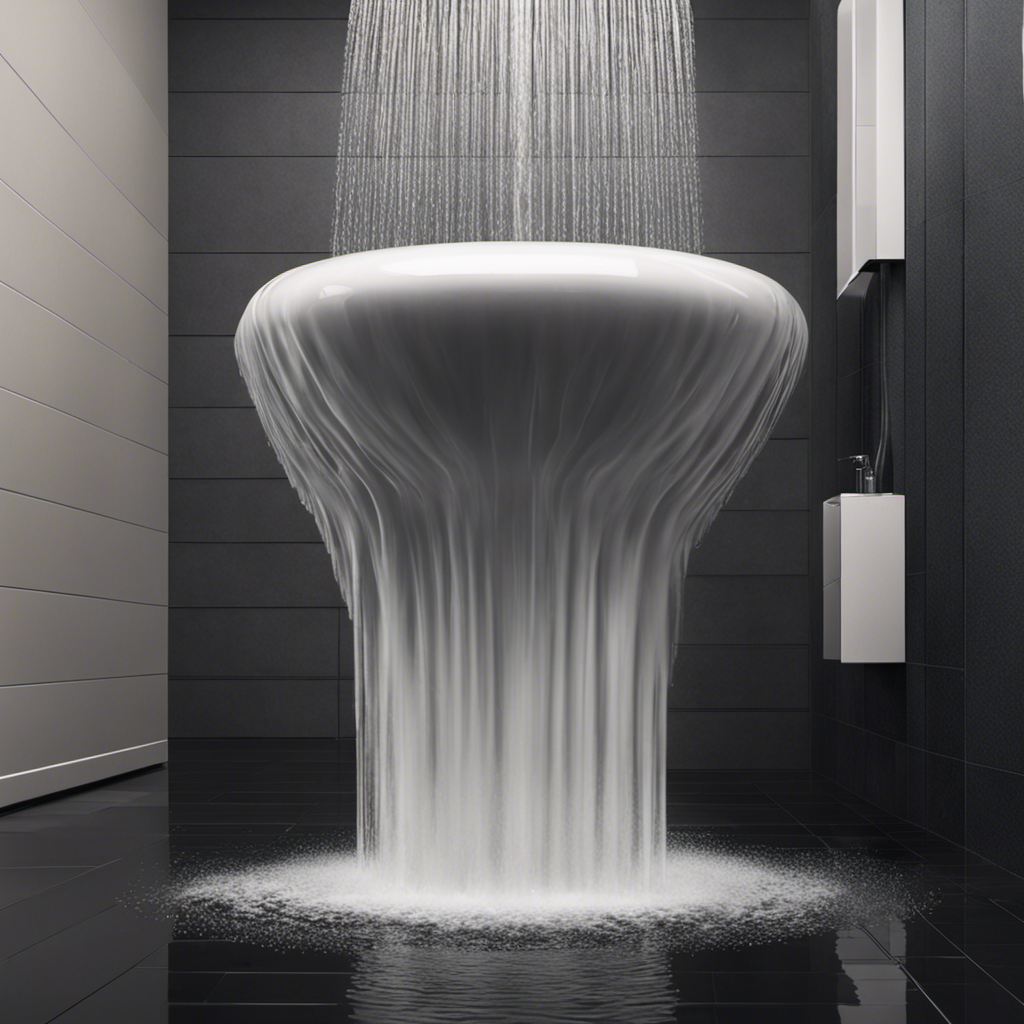Hey there!
Ever wondered how to effectively clean a toilet brush? Well, look no further because I’ve got you covered.
In this article, I’ll walk you through the step-by-step process of cleaning your toilet brush to ensure it’s germ-free and ready for future use. We’ll cover everything from preparing the cleaning solution to removing the debris and disinfecting the brush.
Plus, I’ll share some handy tips for regular maintenance.
So, let’s dive in and get that toilet brush sparkling clean!
Key Takeaways
- Use a mixture of white vinegar, baking soda, and tea tree oil to soak the toilet brush for 30 minutes and remove stains and bacteria.
- Properly clean the brush and storage area to prevent dirt and germ buildup.
- Disinfect the brush regularly using bleach or a disinfectant spray.
- Ensure the brush is stored in a well-ventilated area with bristles facing downwards to prevent bacterial growth and allow for air drying.
Materials Needed
You’ll need a few materials to clean a toilet brush effectively. To start, gather some rubber gloves to protect your hands from any germs or bacteria.
Next, grab a bucket or container filled with warm water. Add some disinfectant or bleach to the water to ensure a thorough cleaning.
You’ll also need a small brush or scrub brush to clean the bristles of the toilet brush. Additionally, have some paper towels or a clean cloth on hand to dry the brush after cleaning.
These materials will help you effectively clean your toilet brush, ensuring that it remains sanitary and in good condition for future use. Don’t forget to regularly clean your brush to maintain its effectiveness and prolong its lifespan.
Preparing the Cleaning Solution
When preparing the cleaning solution, it’s important to mix the ingredients thoroughly. Cleaning tips: using eco-friendly solutions is not only better for the environment, but also for your health. Here is a simple and effective recipe for a homemade toilet brush cleaner:
| Ingredients | Instructions |
|---|---|
| 1 cup of white vinegar | Pour the vinegar into a bowl. |
| 1 tablespoon of baking soda | Add the baking soda to the vinegar and mix well. |
| 10 drops of tea tree oil | Add the tea tree oil to the mixture and stir until combined. |
This cleaning solution is natural and will help remove stains and kill bacteria on your toilet brush. Simply soak the brush in the solution for about 30 minutes, then rinse it thoroughly with water. This eco-friendly cleaner is a great alternative to harsh chemicals and will leave your toilet brush clean and fresh.
Removing the Debris
To effectively remove the debris, it’s important to gently shake or tap the brush over a trash can. This step is crucial in maintaining proper hygiene and preventing the spread of bacteria.
When cleaning a toilet brush, it’s essential to remove any solid waste or toilet paper stuck on the bristles. By shaking or tapping the brush, you can easily dislodge the debris and ensure that it doesn’t end up in your toilet or bathroom floor.
Additionally, it’s important to regularly clean the toilet brush storage area to prevent the buildup of dirt and germs. Proper brush cleaning techniques will help maintain a clean and sanitary bathroom environment.
Now that the debris is removed, let’s move on to disinfecting the brush.
Disinfecting the Brush
When it comes to disinfecting a toilet brush, there are a few key points to consider.
First, it’s important to use effective cleaning methods that will thoroughly sanitize the brush.
Additionally, having the necessary cleaning supplies, such as disinfectant sprays or bleach, is essential for achieving proper disinfection.
Lastly, the frequency at which the toilet brush should be disinfected will depend on factors such as usage and personal preference, but it is generally recommended to disinfect it at least once a week.
Effective Cleaning Methods
You can use a mixture of bleach and water to effectively clean your toilet brush.
To start, fill a bucket or sink with warm water and add about 1/2 cup of bleach per gallon of water.
Submerge the brush in the solution and let it soak for at least 10 minutes.
After that, scrub the bristles with a toilet brush cleaner or a mild detergent.
Rinse the brush thoroughly with hot water to remove any remaining bleach solution.
Make sure to dry the brush completely before storing it in a clean, dry place.
It’s important to clean your toilet brush regularly, ideally after every use, to prevent the buildup of bacteria and germs.
This will help maintain good hygiene and ensure a clean and fresh toilet.
Necessary Cleaning Supplies
Having the right cleaning supplies is essential for maintaining a clean and hygienic bathroom. When it comes to cleaning a toilet brush, there are several options to consider. Here are five alternatives to traditional toilet brushes that are both effective and eco-friendly:
-
Silicone toilet brush: Made of durable silicone, these brushes are easy to clean and resistant to bacteria buildup.
-
Disposable toilet wands: These convenient wands come with disposable cleaning heads, making it easy to clean without the need for a traditional brush.
-
Pumice stone: Ideal for tackling tough stains, a pumice stone can be used to scrub away grime without damaging the porcelain.
-
Toilet bowl cleaner tablets: Drop a tablet into the bowl and let it dissolve to keep your toilet clean and fresh.
-
Vinegar and baking soda: A natural and effective cleaning solution, mix vinegar and baking soda to create a paste and scrub away stains.
With these toilet brush alternatives and eco-friendly cleaning products, you can keep your bathroom sparkling clean while reducing your environmental impact.
Frequency of Disinfection
Disinfecting regularly is crucial for maintaining a hygienic bathroom environment. Cleaning techniques play a vital role in preventing bacterial growth on surfaces.
To keep my bathroom clean, I make sure to disinfect it at least once a week. I start by wiping down all surfaces, including the toilet bowl, sink, and countertops, with a disinfectant spray.
Then, I focus on the toilet brush, which can harbor bacteria if not properly cleaned. After each use, I rinse the brush thoroughly under hot water to remove any residue. Then, I soak the brush in a mixture of bleach and water for about 10 minutes. Finally, I rinse it again and allow it to air dry before returning it to its holder.
Drying and Storing the Brush
When it comes to drying and storing my brush, I’ve found that proper storage and air drying techniques are essential.
First, I make sure to store my brush in a well-ventilated area to prevent any moisture buildup.
Additionally, I always let my brush air dry completely before storing it to avoid any mold or mildew growth.
Proper Brush Storage
To maintain cleanliness, it’s important to store your toilet brush in a well-ventilated area. Proper brush organization and preventing bacterial growth are crucial for maintaining a hygienic bathroom.
Here are some key tips for storing your toilet brush effectively:
- Choose a storage container that allows for air circulation, such as a holder with slots or holes.
- Place the brush in the holder with the bristles facing downwards to allow any excess water to drip off.
- Make sure to clean and disinfect the holder regularly to prevent the buildup of bacteria.
- Avoid storing the brush near other cleaning tools or bathroom products to minimize cross-contamination.
- Keep the brush away from direct sunlight or heat sources to prevent deterioration.
By following these storage techniques, you can ensure that your toilet brush remains clean and ready for use.
Now, let’s move on to the next section about air drying techniques.
Air Drying Techniques
To effectively dry your bathroom cleaning tool after use, hang it in a well-ventilated area with the bristles facing downwards to allow for proper air circulation and prevent bacterial growth. Air drying your toilet brush has numerous benefits. Firstly, it helps to eliminate moisture which can lead to the growth of mold and mildew. Additionally, air drying allows the bristles to fully dry, ensuring that they remain clean and hygienic for future use. If you do not have access to a well-ventilated area, there are alternative methods for drying your toilet brush. One option is to use a fan to increase air circulation. Another alternative is to place the brush in a container filled with a disinfecting solution, allowing it to soak and dry simultaneously. However, remember to regularly clean and replace the solution to prevent bacterial buildup.
| Benefits of Air Drying | Alternatives to Air Drying |
|---|---|
| Prevents mold and mildew growth | Use a fan for increased air circulation |
| Ensures clean and hygienic bristles | Soak brush in disinfecting solution |
| Easy and convenient | Regularly clean and replace solution to prevent bacterial buildup |
Regular Maintenance Tips
Regular maintenance tips for cleaning a toilet brush include rinsing it thoroughly after each use and storing it in a well-ventilated area. This will help prevent the growth of mold and keep your brush clean and hygienic.
Here are some additional cleaning techniques to ensure your toilet brush stays in top condition:
-
Use a disinfectant cleaner: After rinsing the brush, apply a disinfectant cleaner to kill any remaining bacteria or germs.
-
Soak in bleach solution: Periodically, soak the brush in a mixture of bleach and water to remove any tough stains or odors.
-
Scrub with a toothbrush: For a deeper clean, use an old toothbrush to scrub the bristles and handle of the brush.
-
Replace the brush head: If the bristles become worn or frayed, it’s time to replace the brush head to maintain optimal cleaning performance.
-
Store in a brush holder: Keep your toilet brush upright in a brush holder to allow it to air dry completely and prevent mold growth.
Frequently Asked Questions
How Often Should I Clean My Toilet Brush?
I clean my toilet brush every week to ensure proper toilet brush maintenance. Using the best cleaning products for toilet brushes, I keep it clean and hygienic for the next use.
Can I Use Bleach to Disinfect the Toilet Brush?
Yes, you can use bleach to disinfect the toilet brush. However, it’s important to follow best practices and consider bleach alternatives, as using bleach too often can damage the bristles over time.
Is It Necessary to Wear Gloves While Cleaning the Toilet Brush?
Wearing gloves while cleaning the toilet brush is a personal choice. However, it is recommended for hygiene purposes. If you prefer alternatives, consider using disposable gloves or using a tool like tongs for handling the brush.
Can I Clean the Toilet Brush in the Dishwasher?
I learned that cleaning tools can harbor bacteria. While it’s not advisable to clean a toilet brush in the dishwasher, there are alternative methods like soaking it in a bleach solution.
How Do I Know When It’s Time to Replace My Toilet Brush?
When to replace a toilet brush? Look for signs of wear such as frayed bristles, a loose handle, or a foul odor that won’t go away. If it’s time, don’t hesitate to get a new one!
Conclusion
In conclusion, cleaning a toilet brush is a necessary task that ensures a hygienic bathroom environment. By following the steps outlined in this article, you can easily remove debris and disinfect the brush, leaving it fresh and ready for future use.
Don’t let the thought of cleaning a toilet brush deter you, embrace the challenge and turn it into a triumph for cleanliness. Your bathroom will thank you for it!










